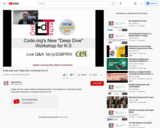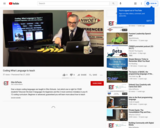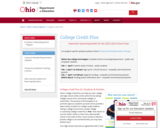
Catalysts of Curiosity: Bridging Curricular Boundaries with STEM ResourcesRoom B140/141Tuesday, February 132:15 p.m. to 3:15 p.m
- Subject:
- Practitioner Support
- Material Type:
- Lecture Notes
- Author:
- Emily Fitch
- Matt Yauk
- Date Added:
- 01/18/2024

Catalysts of Curiosity: Bridging Curricular Boundaries with STEM ResourcesRoom B140/141Tuesday, February 132:15 p.m. to 3:15 p.m

Students learn the importance of the Pythagorean theorem as applied in radar imaging. They use a sensor unit with IRED (infrared emitting diode) to measure triangle distances and the theorem to calculate and verify distances. Student groups calibrate the sensor units to ensure accurate distance measurements. A "pretend" outdoor radar imaging model is provided to groups for sensor unit testing.

Integrating speaking and listening builds a positive classroom community with less bullying, increased self-confidence, and greater independence, along with the ability to work with all students. This article gives ideas for projects or tasks to get students working together.

Students use chromatography to separate the components of ink.

Follow the link to find the Class Admin Guides. This guide provides administrators support articles for LTI and permissions.

The Class support page will take you to resources to help you install and use Class with students and instructors.
Install Guides are provided for macOS, Windows, iPad, and Android/Chrome.
Student Guides are provided for macOS, Windows, iPad, and Android/Chrome
Instructor Guides are provided for macOS and Windows.

Classroom Management with Mixed Reality delivers classroom management strategies that focus on successfully incorporating augmented reality into instruction. This module aims to support educators in understanding the differences between Augmented Reality (AR) and Virtual Reality (VR), implementing mixed reality in their classrooms, and providing suggestions for maintaining positive classroom management with the use of mixed reality.
Classroom Management with Mixed Reality will tackle the difference between virtual reality and augmented reality in a mixed-reality classroom. Along the way, users will define classroom management and investigate multiple techniques. After reflecting on their classroom management practice, users will leave with a toolbox of information and ideas for incorporating more relevant strategies into their classrooms. Differentiate between augmented reality and virtual reality
, Define classroom management , Transform their current classroom management techniques to be more relevant for a mixed reality learning environment
Approximate time to complete this course is 30 min.

Students use bearing measurements to triangulate and determine objects' locations. Working in teams of two or three, they must put on their investigative hats as they take bearing measurements to specified landmarks in their classroom (or other rooms in the school) from a "mystery location." With the extension activity, students are challenged with creating their own maps of the classroom or other school location and comparing them with their classmates' efforts.

Students design, build and test model clay boats that can hold weight.

Accuracy of measurement in navigation depends very much on the situation. If a sailor's target is an island 200 km wide, sailing off center by 10 or 20 km is not a major problem. But, if the island were only 1 km wide, it would be missed if off just the smallest bit. Many of the measurements made while navigating involve angles, and a small error in the angle can translate to a much larger error in position when traveling long distances.

Clusters give you the tools to explore all your diverse interests. Clusters are groups of pathways, or customized learning journeys, designed to help you see a topic through different lenses. Unlike a traditional course, the cluster provides different thematic grouping of concepts. LabXchange developed sequences, or tours, that help you approach a topic from different perspectives.

Learning about adult learning is essential if coaches want to be effective. It's a vital knowledge set. It's foundational to moving the practices of teachers because adults are complex creatures when it comes to learning. In this guidepost, coaches will dissect the theory of andragogy and learn practical steps of application. Coaches will dissect the theory of andragogy and learn practical steps of application.
Approximate time to complete this course is 4 hours. A micro-credential is available from Digital Promise upon completion.

Tools (frameworks) such as TIM (Technology Integration Matrix) can be used to inform the type of support provided in a digital age learning environment. The TIM is designed to assist schools and districts in evaluating the level of technology integration in classrooms and to provide educators with models of how technology can be integrated throughout instruction in meaningful ways to create a digital age learning environment. The model supports and enables educators to design, develop, and infuse digital learning experiences that utilize technology. The goal is to transform learning experiences to result in higher levels of achievement for students. The coach transforms learning experiences to result in higher levels of achievement for students through the use of digital learning frameworks.
Approximate time to complete this course is 3 hours. A micro-credential is available from Digital Promise upon completion.

This resource allows students to search for a Coast Guard recruiter near them.

A deep dive into course materials, teaching practices, and strategies for continuing to teach Code.org's Introduction to Computer Science for K5.

This list is a collection of instructional materials to help educators access resources supporting coding in the curriculum. Each item included in the collection is premium content licensed or purchased by INFOhio or an open access item that has been reviewed by educational professionals. Educators should review all materials before sharing with students.

Over a dozen coding languages are taught in Ohio Schools - but which one is right for YOUR students? Discover the best 3 languages for beginners and the 2 most common mistakes in your K-12 coding curriculum. Beginner or advanced, guaranteed you will learn more about how to teach coding during this session !

This resources walks through the Eight Components of College and Career Readiness Counseling chart a comprehensive, systemic
approach for school counselors’ use to inspire all students to, and prepare them for, college success
and opportunity — especially students from underrepresented populations. The eight components build
aspirations and social capital, offer enriching activities, foster rigorous academic preparation, encourage early
college planning, and guide students and families through the college admission and financial aid processes.
By implementing these eight components, school counselors provide information, tools and perspective to
parents, students, schools and their communities that build college and career readiness for all students.

This webpage provides students and their families with information on Ohio's College Credit Plus Program. Ohio’s College Credit Plus can help you earn college and high school credits at the same time by taking college courses from community colleges or universities. The purpose of this program is to promote rigorous academic pursuits and to provide a wide variety of options to college-ready students.

Explore ways develop multiple communication loops for staying connected with students, parents, and caregivers for digital learning. The educator develops consistent and culturally responsive communications to provide individualized communication to learners and families, and support and updates to the classroom community.
Approximate time to complete this course is 3 hours. A micro-credential is available from Digital Promise upon completion.